
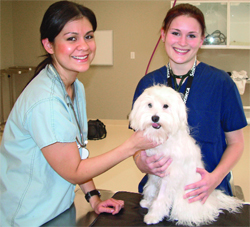 2007 has been a busy year for chiropractors. Whether in private practice, education, a multidisciplinary clinic, research or policy, chiropractors across Canada have shown that the profession knows no limits and that its time has come to tackle all the modern demands of health care in Canada and around the world!
2007 has been a busy year for chiropractors. Whether in private practice, education, a multidisciplinary clinic, research or policy, chiropractors across Canada have shown that the profession knows no limits and that its time has come to tackle all the modern demands of health care in Canada and around the world!
SUPERHIGHWAY TO THE FUTURE
 2007 has been a busy year for chiropractors. Whether in private practice, education, a multidisciplinary clinic, research or policy, chiropractors across Canada have shown that the profession knows no limits and that its time has come to tackle all the modern demands of health care in Canada and around the world!
2007 has been a busy year for chiropractors. Whether in private practice, education, a multidisciplinary clinic, research or policy, chiropractors across Canada have shown that the profession knows no limits and that its time has come to tackle all the modern demands of health care in Canada and around the world!
Canadian Chiropractor magazine is proud to have been a part of the history-making growth of chiropractic this past year – now, we would like to take you back over 2007 and some of the stories that we have had the privilege to cover. Also, we have input from several association presidents as well as from our educational leaders.
Sit back and enjoy this journey into the past – and let it propel you into the future of chiropractic!
Cheers,
Maria DiDanieli
Editor
OPPORTUNITIES AHEAD: ONE VOICE FOR A FRIENDLY FUTURE
By Dr. Stan Gorchynski, DC, president of the Canadian Chiropractic Association
Ensuring chiropractic’s place in health-care delivery and policy-making
“In your position as a leader in the chiropractic profession, what threats and opportunities do you see ahead?”
![]() What will the next 100 years of chiropractic practice in Canada look like? The future of the profession presents many opportunities. At the same time, there are challenges to ensuring Canadians have equitable access to chiropractic care. However, I am of the opinion that the future lies primarily in our own hands. It is ours to mold and I believe the profession is moving steadily forward to create an environment in which chiropractic treatment will be the first stop for neuromusculoskeletal care.
What will the next 100 years of chiropractic practice in Canada look like? The future of the profession presents many opportunities. At the same time, there are challenges to ensuring Canadians have equitable access to chiropractic care. However, I am of the opinion that the future lies primarily in our own hands. It is ours to mold and I believe the profession is moving steadily forward to create an environment in which chiropractic treatment will be the first stop for neuromusculoskeletal care.
One important step into the future is the development of university-based chiropractic research chairs. This program is gaining momentum and has an important role to play in integrating the profession into the health-care continuum. This activity, combined with the clinical practice guidelines initiative, will steadily move the profession into the centre of evidence-based practice and pave the way for enhanced referrals, insurance coverage and patient access. Research will be the currency of credibility in the health system of the future. The CCA, the Canadian Federation of Chiropractic Regulatory and Educational Accrediting Boards, and the Canadian Chiropractic Research Foundation are committed to building a future based on a solid research foundation.
Interprofessional collaboration is another road into the future that we must tread with vigour. Collaborative care pilot projects such as those at St. Michael’s Hospital in Toronto, and Carlingview in Ottawa are the wave of the future. Multidisciplinary studies such as the Bone and Joint Decade Task Force on Neck Pain and Its Associated Disorders also strengthen interprofessional relations, as does membership in organizations such as the Health Action Lobby (HEAL). These are directions that the CCA will continue to pursue to ensure that the chiropractic profession is at the table as an equal partner in health-care delivery and policy-making.
Lastly, internal collaboration is vital to our future. This year, the CCA formed the Strategic Planning Advisory Committee, composed of representatives from all of the profession’s national organizations. The purpose of this committee is to harness the talents and expertise of our advocacy, regulatory, educational, research and protective bodies to build a roadmap for the future that addresses the challenges and seizes the opportunities before us.
It is only through working together, pooling our resources, and speaking with one voice that we can achieve our goals for the future. This must happen across organizations and jurisdictions if we are to fully leverage our resources in the pursuit of success. If we can do that, then we can be confident that the future is friendly!
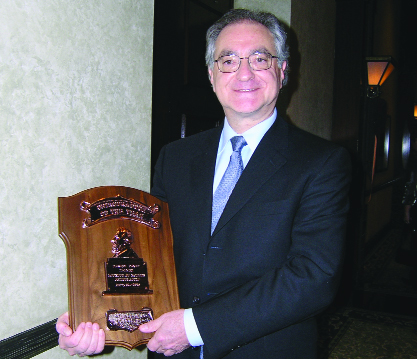 |
| DR. ALLAN GOTLIB HONOURED BY THE OCA
Universally respected for his quiet diligence in advancing chiropractic research and the reputation of the profession, Dr. Allan Gotlib was presented with the OCA’s top honour at the association’s season’s celebration held in early December in Toronto. |
 |
| CHIROPRACTIC PARTNERS WITH VETERINARY SCIENCE AT SENECA COLLEGE
A program starting this spring at Seneca College in Ontario will accept both chiropractors and veterinarians who want to use manual therapies for animals. |
YEAR-END MESSAGE FROM DR. JEAN MOSS, PRESIDENT OF THE CANADIAN MEMORIAL CHIROPRACTIC COLLEGE
2007 has been a year of listening and goal setting.
After a long string of significant accomplishments — construction of, and relocation to, a much-needed larger facility; the completion of the transition to the integrative curriculum; receiving approval from the Ministry of Training, Colleges and Universities to grant a doctor of chiropractic degree; and finding ourselves in a stable financial situation thanks, in part, to the tremendous support for the capital campaign which has enabled us to accelerate the reduction of our building-related debt — CMCC has developed a new vision, mission, strategic direction, and related SMART goals. With a vision to excel in chiropractic education and research, CMCC has been working diligently to engage stakeholders, listening carefully to their thoughts and suggestions on how to build upon our success.
From the Profession Survey that sought input from chiropractors in practice, to the Rebranding Review which explored the image of CMCC from internal and external points of view, the feedback was informative and enlightening. Our courses and resources are valued and our program and research initiatives are important to the overall advancement of chiropractic.
With the overriding objective of enriching the learning environment and ensuring that our program is meeting the expectations of graduates, we received input from students, staff and faculty. This came in the form of an external review of the Office of the Dean, Undergraduate Education, and an internal review of the curricular change process, in addition to an annual student satisfaction survey. The results agree that we have a strong program, excellent faculty and offer a good selection of courses. CMCC’s campus, services and sense of community also has a positive impact on student life. The outcome is graduates who excel in their board exams and who make a positive impact on patients and the profession as a whole. Like many large organizations, however, transparency and communication provide an ongoing challenge with stakeholder groups, and we are working to remove barriers and to open dialogue.
Innovative research is critical to the long-term success of this profession. CMCC is very pleased to have Dr. John Triano, Acting Dean, Graduate Education and Research, driving our new research agenda. Dr. Triano brings, with him, considerable experience, a reputation for pushing the boundaries and asking tough questions which inform everyday practice and improve patient outcomes.
A number of our existing projects continue to have a positive impact on the profession. On campus, a Biomechanics and Elastography Laboratory has opened with the goal to expand our knowledge of the mechanisms of chiropractic manipulation and other aspects of soft tissue biomechanics, especially as they relate to cervical manipulation. Off campus, our clinic at St. Michael’s Hospital continues to offer excellent care even though the grant, for this initiative, was fully utilized in September 2006.
CMCC, St. Michael’s and the Ontario Chiropractic Association have co-operated to keep the project running until permanent funding can be found.
Recognizing the importance of integrative health care, CMCC is planning a Research Symposium on February 1, 2008. The event will bring together world-renowned speakers from Harvard, the Mayo Clinic, the University of Vermont and CMCC. We invite all health-care providers, researchers and students together to expand our understanding of integrative care. To find out more, visit www.cmcc.ca.
What we believe ourselves to be, and what we see ourselves becoming, is reflected in our every thought, action and word. I believe there is no better time to be part of the chiropractic profession. Think, act and speak with great confidence.
| YEAR-END STATEMENT BY DR MARTIN NORMAND, PRESIDENT OF THE CHIROPRACTIC PROGRAM AT THE UNIVERSITÉ DU QUÉBEC À TROIS-RIVIÈRES (FRENCH)
Chaque année est une année importante pour la chiropratique et 2007 m’a pas fait exception. Au Québec, nous avons perdu un de nos grands leaders en la personne du Dr. Normand Danis. Ce départ s’est traduit par l’arrivée d’une nouvelle équipe à l’Ordre des Chiropraticiens du Québec. Une nouvelle équipe apporte souvent de nouvelles idées, de nouveaux objectifs et même de nouveaux partenariats. Nous souhaitons bonne chance à la nouvelle équipe du Dr Gonthier. À l’Université du Québec à Trois-Rivières, après 14 ans d’existence, le programme de doctorat en chiropratique a été restructuré afin d’y inclure de nouveaux cours, dont une clinique étudiante, et de modifier plusieurs autres cours. De fait, de plus en plus d’études scientifiques démontrent que les traitements chiropratiques accompagnés d’une prescription d’exercices spécifiques ont d’excellents résultats. Les résultats préliminaires du groupe de travail «The bone and joint decade» vont également dans ce sens. Dans le but de mieux outiller les futurs professionnels de la santé, des cours de réadaptation et de prescription d’exercices ont été ajoutés au programme. Au cours de la dernière année il y a eu l’établissement d’une chaire de recherche qui a grandement dynamisé les activités de recherche du département de chiropratique. Il est important de souligner que la profession a fait de gros efforts au cours des dernières décennies pour développer la recherche. Comme vous le savez tous, la reconnaissance passe par les connaissances. Souhaitons-nous une année 2008 pleine de nouvelles connaissances. |
YEAR-END STATEMENT BY DR MARTIN NORMAND, PRESIDENT OF THE CHIROPRACTIC PROGRAM AT THE UNIVERSITÉ DU QUÉBEC À TROIS-RIVIÈRES (ENGLISH)
Each year is an important year for the profession of chiropractic and 2007 has been no exception. In Quebec, we have lost one of our greatest leaders in the person of Dr Normand Denis. His passing gave rise to the formation of a new team at the Order of Chiropractors of Quebec. A new team often brings with it new ideas, new goals, as well as new partnerships. We would like to wish Dr Gonthier’s new team the best of luck. After 14 years of existence, the Doctor of Chiropractic program at the University of Québec at Trois-Rivières has been restructured to include new courses, such as clinical practicums, as well as changes in several existing courses. In fact, more and more, scientific studies are demonstrating that chiropractic treatments accompanied by a regimen of specific exercises result in excellent outcomes. Preliminary results from the “Bone and Joint Decade” committee are in agreement with these findings. In an effort to better equip our future health-care professionals, training in rehabilitation and exercise regimens has been added to our program. In the course of the past year, we have established a Research Chair which has greatly escalated research activities within the chiropractic program. It is important to underscore the great efforts that the profession has made, in the past decade, to develop its research capacity. As you all know, from knowledge comes understanding. For 2008, we would like to wish the profession a new year that is rich in discovery and learning. |
PROFESSION MOURNS PASSING OF QUEBEC LEADER
With humour, grace and determination, Dr. Normand Danis served the chiropractic profession.
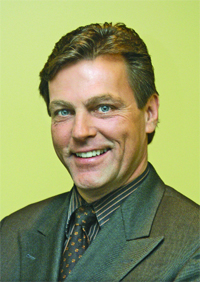 On April 14 in Montreal, Quebec chiropractors paid tribute to a man who had protected, defended and promoted them for over two decades. After just a few months of illness, Dr. Normand Danis was dead at the age of 52. He left vacant the important position of president of the Ordre des Chiropraticiens du Québec (OCQ), the regulatory body that oversees the province’s nearly 1,100 chiropractors.
On April 14 in Montreal, Quebec chiropractors paid tribute to a man who had protected, defended and promoted them for over two decades. After just a few months of illness, Dr. Normand Danis was dead at the age of 52. He left vacant the important position of president of the Ordre des Chiropraticiens du Québec (OCQ), the regulatory body that oversees the province’s nearly 1,100 chiropractors.
Chiropractic leaders from across Canada joined mourners in the Église St-Laurent where the funeral service was conducted for Dr. Danis. Apart from being a family man and a clinical chiropractor, he was undoubtedly the most influential person in the Quebec profession’s modern-day development.
A 1980 graduate of the Canadian Memorial Chiropractic College, Dr. Danis served as president of the Association des Chiropraticiens du Québec (ACQ), and as a member of the board of governors of the Canadian Chiropractic Association (CCA). He was co-chair of the Guidelines Development Committee established jointly by the Canadian Chiropractic Association and the Canadian Federation of Chiropractic Regulatory and Educational Accrediting Boards.
After practising for seven years in the Montreal area, Dr. Danis was invited in 1987 to take on the OCQ presidency, a role that he carried out with vigour, courage, vision and dignity.
He was twice named ACQ’s Chiropractor of the Year, and was honoured with Canadian Chiropactor magazine’s award of the same name in 2004. A fellowship was bestowed upon him by the International College of Chiropractors, and in 1998 Dr. Danis was a recipient of the CCA’s prestigious Medal of Merit.
“I have been with Normand for the past 12 years on the Quebec board. Normand has made me a better man in every aspect of life, especially as a chiropractor, as he has made better all the people that he met during his 20 years as president of the Ordre des Chiropraticiens du Québec. I will not talk about his accomplishments as this would take too many pages. All I will say is that Normand elevated everyone he met to be better individuals.”
Dr. Richard Dussault
Secretary-Treasurer, Ordre des Chiropraticiens du Québec
“We travelled across Canada together for 15 years, at least two or three times a year. Stories about those trips – I have thousands. We made quite a team together … and, as we say, what happens on the road stays on the road. And he kept telling me, ‘Board meetings are mathematics, Daniel. Make sure you count the votes around the table.’ In more than 20 years of working together, we never had an argument. We were always on the same wavelength all the time; we always came to a consensus. You could have asked both of us the same question and you would get the same answer.”
Dr. Daniel Saint-Germain
Secretary-Treasurer, Canadian Federation of Chiropractic Regulatory and Educational Accrediting Boards
(From the eulogy he delivered at Dr. Danis’ funeral service)
“Dr. Normand Danis will stand in our memory forever as a champion of chiropractic in Canada. It is important for you to know how many close friends Normand has in every province of this country and how loved he was. At the federal level, he was a champion of professional unity, of co-operation, and of ensuring Quebec’s place at the table. When we faced our most challenging regulatory issues at the federal level, we turned time and time again to Normand. And he never failed us. His word was accepted by the leadership of the profession across this country. His contribution cannot be denied and will never be forgotten.”
Dr. Keith Thomson
President, Canadian Federation of Chiropractic Regulatory and Educational Accrediting Boards
“Dr Normand Danis was a chiropractor totally engaged for the chiropractic profession with passion, intelligence and determination. I was privileged to share a friendship with him through the years. I admired the flair and intelligence he used in all situations. He has been carrying the chiropractic flag for us with pride, and now we should continue to do so in his memory.”
Dr. Jocelyn Ouimet
Past President, Canadian Chiropractic Association; Past President, Association des Chiropraticiens du Québec; Director, Canadian Chiropractic Protective Association
“Normand was my junior at CMCC, so our relationship goes back 30 years. Those of you who knew him know that his love and passion for chiropractic was equivalent to his love and passion for life. He is today rejoicing after a few months of deep physical suffering. Let’s choose to
live our purpose as a tribute to a great man who at the tender age of 52 leaves us a legacy of joy, truth, passion and compassion.”
Dr. Gilles Lamarche
President, College of Chiropractors of Ontario
“Dr. Danis has been a giant for the chiropractic profession. His knowledge and understanding of chiropractic as a whole have been matched by very few in the last 20 years.”
Dr. Christian Beaudry
Longtime friend of Dr. Danis
“Dr. Normand Danis’ years as president of the Ordre des Chiropraticiens du Québec could perhaps be described correctly and explicitly in a 300-page book. I will attempt to do it here in a few sentences.
“Dr. Danis should be remembered as a truly remarkable North American chiropractor. His continuous work with the Quebec regulatory board demonstrated the breadth of his leadership in political activities, administration, and research and guidelines development. One of his best qualities was the surgical capacity to analyze situations and come up with efficient solutions. He always put principles first before action. He sought to bring innovation into his profession, and excellence was his only objective.
His accomplishments, dedication and expertise, in a 20-year span, are unprecedented in Canada. His departure will be a great loss for the whole chiropractic profession as well as for his family and close friends.”
Dr. Daniel Boisvert
1st Vice-President, Ordre des Chiropraticiens du Québec
“Three words for a great man and a giant doctor of chiropractic: perseverance; unification; confidence. Perseverance: A tireless worker, stubborn, patient, he never calculated the hours, the days, or even the number of months necessary to reach his goal, which was to build a better profession, a better chiropractic world for all of us and for the public at large, our patients. Unification: Despite the different opinions against him or around him, he always succeeded in having us around the table, working and reaching a consensus. He was a great and powerful debater. You had to be very solid to have him change his opinion. Once done, he was your best ally. He was the expression of a true leader. Confidence: He was always successful in the critical and fearful times to have us reach deep inside our core to regain confidence and power to win our battles or simply to advance, one inch at the time, on a painful day or mission. I remember him saying, ‘André-Marie, a chiropractor never quits in the face of an obstacle. He continues his work with intensity and faith, and he will win.’ How many times I saw this phrase in action, and how many victories were obtained. And today, I still use this phrase, and it works. The program in chiropractic at the Université du Québec à Trois-Rivières (UQTR) is just one example.”
Dr. André-Marie Gonthier
Professor, Clinical Sciences, Chiropractic Program, UQTR
“Dr. Danis spent the last 27 years of his life breathing the philosophy, science and art of chiropractic. Recently, he worked so hard with all of us to create the Quebec Chiropractic Research Chair at the Université du Québec in Trois-Rivières, of which he was so proud. I am so happy that he was part of this inauguration.
“I lost a great friend, a great supporter, and the profession lost a ‘chiropractic master.’”
Dr. Guy Beauchamp
President Fondation de Recherche Chiropratique du Québec (Quebec Chiropractic Research Foundation)
“For the past 20 years, I have had the pleasure of working for Dr. Normand Danis, chiropractor, president of the Ordre des Chiropraticiens du Québec. During the course of these years, I have witnessed him to be a diligent, passionate and devoted worker who dedicated his life to the chiropractic profession. Lastly, my colleagues and I are unanimous in saying that Dr. Danis was a very good boss.”
Denise Giguère
Administrative Secretary
Ordre des Chiropraticiens du Québec
“Dr. Normand Danis left us too soon. With focused passion, he lived a committed life for his family and his profession, and achieved remarkable results in both endeavours.
“As president of the Ordre des Chiropracticiens du Québec, he pro-tected the scope of chiropractic practice within Quebec by assisting in the battle to retain diagnosis within the scope, he oversaw the regulatory issues that arose within his province, and he contributed to the establishment of a strong national chiropractic federation of regulatory oversight. In each of his interactions and along with his ever-ready personal warmth and humour, Normand consistently provided high-level statesman and leadership qualities, keen insight and an innate ability to find solutions to complex and challenging issues. Among his many responsibilities, he also co-chaired the Guidelines Development Committee for the past number of years, which produced the recently released clinical practice guideline on adult neck pain not due to whiplash, a state-of-the-art milestone in the process of guideline development.
“Dr. Danis served the profession as few have, and his contributions have become a foundation upon which the future of the profession shines that much brighter. Both within Quebec and the rest of Canada, Normand’s influence and contributions have left a trail of friendship, accomplishment and a sense of destiny for the profession that has inspired and rallied his colleagues. I will miss him, his profession will miss him, but we are all that much richer to have had him as one of our own. Thank you for your friendship, your vision and your inspiring leadership, Normand; you will be forever in our hearts and memories.”
Dr. Stan Gorchynski
President, Canadian Chiropractic Association
DR. MARK ERWIN NAMED THE CANADIAN CHIROPRACTIC RESEARCH FOUNDATION SCIENTIST IN DISC BIOLOGY
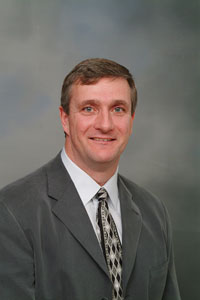 The Canadian Chiropractic Research Foundation has another exciting major announcement to make! The Foundation has entered into an agreement directly with the University of Toronto to create and fund the position of CCRF Scientist in Disc Biology.
The Canadian Chiropractic Research Foundation has another exciting major announcement to make! The Foundation has entered into an agreement directly with the University of Toronto to create and fund the position of CCRF Scientist in Disc Biology.
This three-year position will be held by Dr. Mark Erwin DC, PhD., who is an Assistant Professor in the Department of Surgery in the Faculty of Medicine at U of T.
Dr. Erwin's new position and his revolutionary research, are supported by the CCRF, the University of Toronto, the Ontario Chiropractic Association and the University Health Network in Toronto.
The Ontario Chiropractic Association is a major partner in supporting this position. The OCA Board members are acknowledged for their tremendous commitment and leadership in this initiative.
The University of Toronto is Canada's largest university, recognized as a global leader in research and teaching.
The UHN is among the ranks of the world's leading health providers of exemplary patient care and innovative research and teaching.
This direct agreement with a university provides for a $300,000 investment in building the credibility of our profession and follows closely on the earlier investments with the University of British Columbia and the University of Manitoba.
Congratulations go to Dr. Erwin on achieving this prestigious position – the CCRF directors and officers are delighted with the progress to date.
HALF A CENTURY AND GOING STRONG!
The Journal of the Canadian Chiropractic Association celebrates its 50th anniversary
Dr. Allan Gotlib
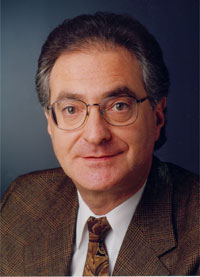 I am proud to announce that this year marks the fiftieth anniversary of the Journal.
I am proud to announce that this year marks the fiftieth anniversary of the Journal.
The “Canadian Chiropractic Journal” was inaugurated in January of 1957. The editor was Dr. Don Sutherland and Volume 1, No. 1, carried an editorial regarding ‘authoritative communication’ which has, since, been reprinted in the December issue of the JCCA to reflect on the times. Dr. Sutherland stated “An adequate means of communication is vital if we are to go far. What army will try to advance without an assured line of communication?”
Also in that issue, were the words of the president of the Canadian Chiropractic Association in 1957, Dr. G.H. Young, of Vancouver, who said “It is time that Canadian chiropractic began to spread its wings and go places”. And so, the journal began it’s flight.
The last issue of that year, Volume 1, No. 5, carried a significant editorial regarding each member’s responsibility to the profession. This was authored by another of the profession’s exemplars, Dr. H.K. Lee, who was also the journal’s associate editor and has also been reprinted. Dr. Lee wrote,
“From the scientific standpoint, have you ever stopped to ask yourself, ‘Have I ever made any contribution from a research point of view and shared it with my fellow chiropractors?’ It is so easy to leave investigation to a few and go along in the same old rut year after year.”
These two editorials set the stage for professionalism, asked highly pertinent questions and created very important “expectations”. They are timely, even today, 50 years later. I encourage you all to read them.
The first issue of the Canadian Chiropractic Journal also carried the Clinic News section edited by Dr. H.L. Gauthier, then our Clinic Director. Also noteworthy, was the first case history prepared by Walter Coveyduck who was a senior intern from Hamilton.
Today, the Journal of the Canadian Chiropractic Association (JCCA) sits on the library shelves of 120 of the world’s leading health sciences universities.
The Journal’s Editorial Board consists of an international group of chiropractic experts who receive, nurture and approve the scientific contributions the profession makes to the global research community. The JCCA not only adds to the scholarly literature of the scientific community, but it also withstands its rigorous scrutiny.
The JCCA, this year, has become part of the PubMed databases system and is now digitally archived at the U.S. National Institutes of Health (NIH) which was developed and managed by NIH’s National Center for Biotechnology Information (NCBI) in the National Library of Medicine (NLM). This has brought tremendous credibility to our profession.
The Journal has become the vehicle to document the clinical evidence that we, as clinicians, experience everyday in our practice with our patients and has indeed facilitated a true research culture in the profession.
Dr. Allan Gotlib is the editor of the Journal of the Canadian Chiropractic Association and the Director of Research Programs for the Canadian Chiropractic Association.
DAVID STUBBS, PAST EDITOR,
CANADIAN CHIROPRACTOR MAGAZINE
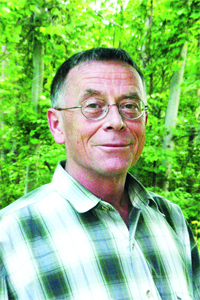 |
| In July 2007, Canadian Chiropractor magazine said "adieu" to David Stubbs. David was the editor for the magazine for three years and, during that time, elevated the publication to new heights. Prior to editing Canadian Chiropractor, David acted as a proofreader for our parent company, Annex Printing and Publishing, Inc. David's history involves massage therapy and extensive travelling experiences. He has moved on to new projects but communicates with us often – he misses his chiropractor friends and wishes to extend a happy new year to all! Good luck, David – your wit and insight were invaluable and the profession of chiropractic, in Canada, won't forget you! |
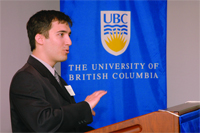 |
| CCRF HOSTED AT UBC DONOR RECOGNITION EVENT
The Canadian Chiropractic Research Foundation and the University of British Columbia jointly established the CCRF Professorship in Spine Biomechanics and Neurophysiology at the School of Human Kinetics. Dr. Jean-Sébastien Blouin (above) was named to that tenure-track assistant professorship position. |
CHIROPRACTIC AT THE PAN AMERICAN GAMES, RIO, 2007
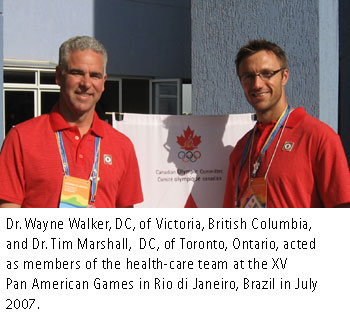
Rio de Janeiro, Brazil, provided the spectacular setting for the largest multi-sport event of 2007, the XV Pan American Games, July 13 to 29. Fifty-eight hundred athletes from 42 countries in the Western Hemisphere competed in 34 sports, many looking for automatic qualification for the Beijing 2008 Olympics. Canada sent 470 athletes (the largest team ever sent overseas) to the Games and won a record 137 medals, finishing third overall in medal count behind the U.S. and Brazil. Along with the athletes, Canada sent a mission support staff of 275 coaches, travel professionals, media liaisons and a full contingent health-care team. The health-care team consisted of seven medical doctors, nine physiotherapists, eight athletic therapists, four massage therapists, and two doctors of chiropractic, Dr. Wayne Walker of Victoria, B.C., on the core medical staff, and Dr. Tim Marshall of Toronto, with the women’s gymnastics team.
The athletes’ health clinic was on the second floor of Canada place – our athletes and staff were housed in two 10-story condominium buildings in the Athletes’ Village – and was designed to effectively deal with a large number of patients simultaneously. Divided into two sections, each about 1,200 square feet in size, the clinic housed a waiting room with an open treatment area consisting of two treatment tables, as well as an Internet room (for charting files), and two private offices with ensuite bathrooms, one for MDs and one for chiropractic care, in one half and a therapy section consisting of four tables in an open area, three private rooms (each with two treatment tables) as well as two tables on the large balconies overlooking the village and the surrounding rainforest. The chiropractic office had two tables, donated by the CCSS(C) as well as two portable drop pieces and head rest paper donated by Dr. Brian Seaman to complete the basic needs. The Canadian Olympic Committee (COC) provided a fully functional clinic including a coffee/lunch room with snacks and drinks, several laptop computers for patient charting, and personal care
items, as well as a wide variety of clothing items. Athletes’ records were kept electronically on the CAMP website (Canadian Athlete Monitoring Program) using the injury zone program that contains all past medical historical data and details of each athlete’s health-care encounters.
This system worked very well and allowed all the members of the health team to easily see what treatments had been administered and by whom, so interdisciplinary consultation and referral was greatly simplified. The health-care staff truly functioned as a team, and Dr. Walker greatly appreciated the support and co-operation of Dr. Mike Wilkinson, the chief medical officer, and the therapists who all referred athletes for chiropractic care and worked together seamlessly in providing the best care possible. Patients were allowed to sign up for treatments on a same-day and next-day basis, with clinic hours from 7 a.m. to 10 p.m. (usually we were treating until 11 p.m.). Time off was precious, as we were somewhat understaffed, but Dr. Walker was able to attend athletes at the cycling, beach volleyball, swimming/diving/synchronized swimming and track and field venues in midday after providing pre-competition treatments in the mornings. Dr. Marshall attended the Canadian women’s gymnasts, who were the most delightful athletes in the Village – our youngest athletes as part of their development program – who epitomized the Canadian Olympians’ attitudes of friendliness, politeness, poise and grace.
Dr. Ken Thomas of Parker College, Dallas, led a U.S. delegation of chiropractors that treated several of the smaller countries at the Games, and the U.S. and Brazil also brought their own chiropractors as part of their core health staff.
The experience of marching into the opening ceremonies with the Canadian team before 110,000 cheering Brazilians is something that none of us will ever forget, and the pride of contributing to their winning performances through chiropractic care is something that all sports chiropractors share. Dr. Walker and Marshall would like to thank the CCSS(C) for all it has done to continue the participation of chiropractors in the major Games as part of the Canadian health-care team, and to all those who made our opportunity to serve these amazing Canadian athletes such a memorable experience.
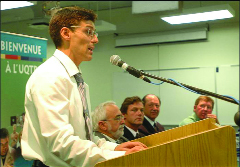 |
| PROMOTING CHIROPRACTIC RESEARCH AT TROIS-RIVIERES Named to the FRCQ/Platinum System Chiropractic Research Chair at the Université du Québec à Trois-Rivières, Dr. Martin Descarreaux speaks to those gathered for the inauguration. Seated, left to right, are: Dr. René-Paul Fournier, research and teaching provost at UQTR; Dr. Normand Danis, president of the Ordre des Chiropraticiens du Québec; Dr. Guy Beauchamp, president of the Fondation de Recherche Chiropratique du Québec; and Dr. Martin C. Normand, director of the chiropractic department at UQTR. |
COMBINING A CRUISE WITH CONTINUING ED
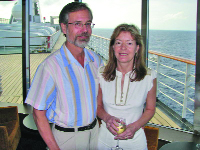 |
| On deck in the southern Caribbean: Dr. Donald and Janet Langford, of London, Ontario. |
Nineteen chiropractors from six provinces, along with their significant others and friends sailed away in February onboard Holland America’s Maasdam. The 10-day itinerary of the third ChiroCruise included the Caribbean islands of St. Lucia, Martinique, St. Maarten, Tortola, Barbados and the Bahamas.
During three at-sea days, presenters Peg Seron, DC, DACBR, DABCO, and her husband, John Hyland, DC, DACBR, DABCO, offered eight hours of continuing education on the imaging of disc pathology.
Reportedly perfect weather enhanced the many shore excursions, which permitted exploration of the islands, and swimming and snorkeling in the turquoise and royal blue waters of the Caribbean.
The passenger list included Dr. Donald and Janet Langford, of London, Ontario. Dr. Langford was the lucky recipient of a cruise giveaway for two co-sponsored by Canadian Chiropractor magazine and ChiroCruise. His name had been drawn at the Canadian Chiropractic Convention in Vancouver last November.
Hosts and ChiroCruise founders Dr. Steven and Marjory Benson of Victoria, British Columbia, are already making plans for the fourth ChiroCruise, which will set sail in 2008.
SOME OF OUR ASSOCIATION PRESIDENTS SPEAK TO CHIROPRACTORS ACROSS THE COUNTRY
Dr. Norm Skjonsberg, president of the New Brunswick Chiropractic Association
A Bigger Picture
The Chiropractic profession has a long history of isolation. Isolation in the sense of being set aside from mainstream medicine and even amongst ourselves with different opinions on techniques, policy and philosophy between our International, National and Provincial Associations, and even our individual practitioners.
The challenges we encounter on a daily basis at the provincial level and even within our individual offices are the same challenges experienced by our colleagues on the International and National levels. The discrimination toward chiropractic based on misunderstanding, from mainstream medicine, the uncertainty and fear of new patients to try chiropractic as a result of a misinformation based on biased media reports and individual patient perception based on public opinion are but a few of the daily challenges.
Our profession as viewed by outsiders, is still perceived as being a splintered group of isolated pseudo-doctors with a treatment protocol based on pseudo science. Fortunately we are now realizing that the outsiders perception is in fact the reality on how we are judged and unless we take affirmative proactive action we will be faced with increasing isolation, a loss of identity and eventually extinction of the profession as we know it.
“ The profession has not resolved questions of professional and social identity … chiropractic stands at the crossroads of mainstream and alternative medicine.” Meeker and Haldeman 2002.
The WFC has recognized the need for an international public identity that is similar in all countries and is working towards achieving that through the establishment of the Three Concepts, which are as follows:
A leading statement on identity, which must be clear, concise and immediately relevant to both the public and the profession – the ‘pole’ (brand platform).
Several important qualifying statements, which provide the necessary context and foundation for the pole –the ‘ground‘ (brand pillars)
A description of the qualities or essential personality of chiropractors – the "personality" (tone).
(WFC Congress, Sydney, Australia,June 15,2005).
The CCA researched and developed the six pillar foundation, which is the base to pursue professional credibility for chiropractic in Canada. The six pillars consist of:
- collaboration
- clinical/Ethical excellence
- research
- clinical and Educational relationships
- government Relations
- interprofessional relationships.
The Three Concepts and the Six-pillar Foundation will benefit us by removing the barriers creating isolation of our members and by changing the outsider’s perception of our profession.
Due to the overwhelming support of my spouse Pearl -who is also my best friend and chiropractic colleague – my daughter Chantal and all the members of the New Brunswick Chiropractor’s Association, I have had the privilege of serving the NBCA since 1997. The different roles I have been involved with on behalf of the NBCA have allowed me to develop a bigger picture of our profession.
I can clearly see that Chiropractic in New Brunswick is also dealing with issues of professional and social identity, as it stands at the crossroads and is in danger of increasing isolation from mainstream medicine.
However, there is a bright future as we continue to build on the success of the dedicated provincial and national leaders that served before us.
We have learned that to prevent isolation on an individual level we need to be involved in the community, interact with our colleagues, openly communicate with the other health disciplines and develop clinical excellence within our practices.
The provincial level requires member participation to develop programs, such as government relations, so we can provide direction to the decision makers on healthcare policy. We must also fully embrace the initiatives set forward by the WFC and CCA to develop a distinct professional and social identity to rightfully proclaim Chiropractic as the world’s leading health care profession that you and I know it to be.
Respectfully Submitted
Dr. Norm Skjonsberg, NBCA President
Dr. Donald Earle, president of the Newfoundland and Labrador Chiropractic Association
Chiropractic has been ever-evolving. Evidence-based care is the new buzz word in health care these days.
A recent development has been the recommendation by the American College of Physicians, and the American Pain Society, in the diagnosis and treatment of low back pain. For those who are unfamiliar with this guideline, the panel recommended spinal manipulation for low back pain, second only to self care and NSAIDs. The important thing to note here is that these recommendations are based on the current evidence available and were made by an independent panel. The guidelines were published in the Annuals of Internal Medicine, October 2007 Vol 147, and can be viewed on their website.
I believe as a profession we need to have one unified voice in Canada. I think we can all agree, regardless of our backgrounds and ideology, that we are stronger when we stand together. There has been a lot of interest lately in defining this voice, a big challenge to say the least.
In the ten years that I have been in practice, I have seen many changes in both the profession and in my own practice. I am convinced, now more than ever, that cooperation and open communication with other health care professionals is vital and it serves our patients well to insure that we are an integral part of the health care team. In my view, it is this cooperation that will bring us into mainstream health care.
I also see the publication of the clinical practice guidelines (CPG) as huge step forward for our profession. It has been a major undertaking and gives our clinicians a consistent frame work for patient care.
Chiropractic is in the forefront in this regard and it demonstrates our expertise in managing musculo-skeletal conditions.
As primary health care providers, we need to be involved in developing health care policy both provincially and nationally. The work our profession has done with the CPG, and other areas of research, will give us the tools we need so we can be major stakeholders in writing health care policy and reform.
Dr. Vince Adams, president of the Prince Edward Island Chiropractic Association
The health care environment in Canada is rapidly changing. All health professions, as well as the government of Canada, has been evaluating how to deal with the social and financial pressures of providing our aging population of baby boomers with health care.
The chiropractic profession must play a vital role in this evolving health care crisis to survive. We must evaluate our past difficulties and learn from both our weaknesses and our strengths.
One of our greatest weaknesses is, sometimes, our lack of unity on certain issues, however we have evolved and we have shown a maturity during crisis situations. The evolution of chiropractic from a provincial interest to a national interest is slowly changing and I feel a general momentum or strengthening towards national unity is not too far in the distant future. There still will be individual provincial issues, however unity on many platforms will help reduce redundant and costly services.
Our profession has been developing an ongoing comprehensive strategic plan which will address these strengths and weaknesses. This plan involves being very active in communication, research and government relations.
A strong fundamental basis of research, including our Clinical Practice Guidelines, will increase our credibility among both the third party payers as well as policy makers especially since these guidelines are non-biased.
Our communication activities are designed to allow a higher level of interaction among our members, associations and the media. These activities will unite our profession internally with our members. It will also inform the health care stakeholders, and the general public, that we are musculoskeletal specialists that can offer an efficient and cost effective treatment for a variety of muscle and joint problems.
We must move forward as a united national body and be present at the government tables during discussions on health care policies. These policies will affect our profession at both the national and provincial levels.
I feel that this profession can look forward to a bright future as a leader in health-care reform.
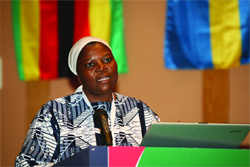 |
| A GLITTERING CELEBRATION
“A Celebration of the Past, Present and Future of Chiropractic” was the title and theme of the World Federation of Chiropractic’s 9th Biennial Congress and the European Chiropractic Union’s 75th Anniversary Convention held in Vilamoura, Portugal, from May 15 to 19, 2007 – and it was the profession’s brightest celebration ever held in Europe. |
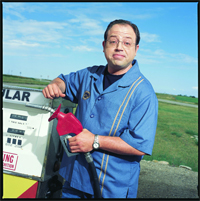 |
| SASKATCHEWAN COMMEMORATES A CENTURY OF CHIROPRACTIC Saskatchewan, where Canada’s first chiropractor began practicing 100 years ago Commemorates a Century of Chiropractic in Canada – the Chiropractor’s Association of Saskatchewan organized a successful gala that was held on November 16 at the Hotel Saskatchewan Radisson Plaza in Regina. Brent Butt, from the well-known Canadian sitcom, Corner Gas, added his humour to the occasion. Photo courtesy of CTV |
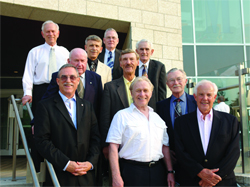 |
| CMCC REUNION
CMCC’s 50th anniversary class, the Class of 1957, came back together for the college’s Homecoming weekend. From left to right, back row – Dr. Ray Zindler and Dr. Jim Reilly; second row from the back – Dr. Metro Kuruliak and Dr. Stan Faught; second row from the front – Dr. Rene Bureau, Dr. Ed Martinuk and Dr. Fred Strukoff; front row – Dr. Ron Oswald, Dr. Bernie Fruitman and Dr. Don Moore. Other class members who attended but were not in the photograph: Dr. J.B. Fleming, Dr. J.D. Rennicks and Dr. Ronald Whiting. Photo courtesy of Canadian Memorial Chiropractic College |
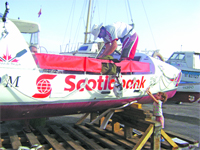 |
| BRITISH COLUMBIA CHIROPRACTOR DR. PAUL ATTALLA TO ROW SOLO ACROSS THE ATLANTIC
Fernie, British Columbia, chiropractor Dr. Paul Attalla left for Northern Africa on October 31, 2007, where he will prepare for his solo journey in the 2007 Atlantic Rowing Race; a journey in which he will cross the Atlantic Ocean, with no motor or sail, in his 24-foot boat. Sponsored by ScotiaBank, 36-year-old Dr. Attalla will be the only Canadian participant in this event and one of only five who will row solo. Please visit www.cndoctor.ca for the full story of this arduous 5,500-kilometre journey that commenced on December 2, 2007, from the Canary Islands. |
We at Canadian Chiropractor magazine would like to wish all our readers and our sponsors the very best in the coming year.
Print this page